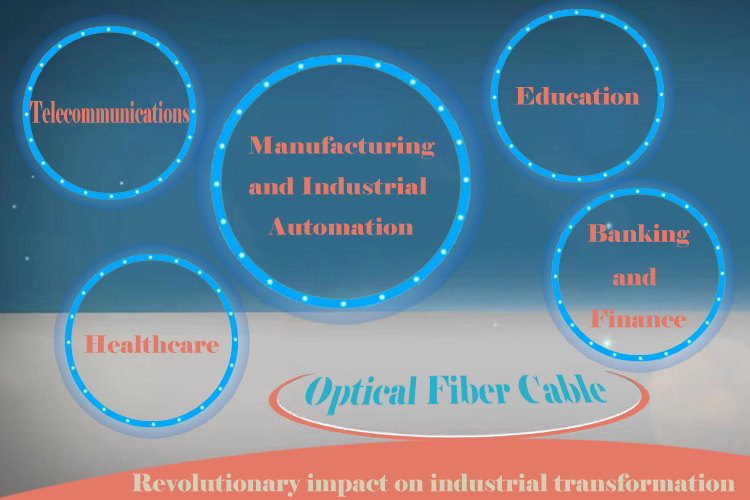The Revolutionary Impact of Optical Fiber Cables: Transforming Industries
Introduction
In today's fast-paced digital world, communication and data transmission play a vital role in the success of businesses across various industries. The emergence of optical Fiber cables has revolutionized the way information is transmitted, leading to significant advancements and transformative changes in numerous sectors. This article explores the profound impact of optical Fiber cables on various industries and how they have paved the way for innovation, efficiency, and connectivity.

Optical Fiber Cables: Unleashing the Power of Light
Optical Fiber cable, also known as fiber optic cable, are thin, flexible strands of glass or plastic that transmit data and information through the use of light pulses. Unlike traditional copper cables, which rely on electrical signals, optical cables utilize the speed and reliability of light to transmit data over long distances without any degradation. This breakthrough technology has opened up a world of possibilities, transforming industries and pushing the boundaries of what was once thought possible.
1. Telecommunications: Connecting the World
The telecommunications industry has been at the forefront of adopting optical Fiber cables, recognizing their ability to revolutionize how information is transmitted. With the exponential growth of internet usage and the demand for high-speed data transfer, optical Fiber cables have become the backbone of global communication networks.
Optical Fiber cables have vastly increased data transmission capacity, enabling high-speed internet connections and seamless video conferencing. They have also facilitated the expansion of mobile networks, allowing for more reliable and efficient wireless communication. As a result, people around the world can easily connect with each other, fostering global collaboration and innovation.
2. Healthcare: Enhancing Medical Diagnostics and Treatment
In the healthcare industry, optical Fiber cables have brought about significant improvements in medical diagnostics and treatment. Medical imaging techniques such as endoscopy, ultrasound, and magnetic resonance imaging (MRI) rely on the clarity and precision of optical Fiber cables to capture detailed images of the human body.
Optical Fiber cables enable the transmission of high-resolution images and real-time video feeds, allowing medical professionals to make accurate diagnoses and perform minimally invasive surgeries. This technology has revolutionized procedures such as laparoscopy and arthroscopy, reducing patient recovery time and improving overall healthcare outcomes.
3. Banking and Finance: Securing Transactions and Data
The banking and finance sector handles vast amounts of sensitive data, making security a top priority. Optical Fiber cables have played a crucial role in ensuring the safe and efficient transmission of financial information.
By utilizing light signals instead of electrical currents, optical Fiber cables are immune to electromagnetic interference, making them highly secure for transmitting confidential data. This technology has facilitated the development of secure networks, enabling online banking, electronic fund transfers, and secure communication between financial institutions. Optical Fiber cables have become the backbone of global financial systems, safeguarding transactions and protecting sensitive customer information.
4. Manufacturing and Industrial Automation: Streamlining Production Processes
In the manufacturing and industrial automation sector, optical Fiber cables have revolutionized production processes, leading to increased efficiency and productivity. Optical Fiber cables enable high-speed data transfer and real-time communication between machines, allowing for seamless integration and coordination.
With the use of optical Fiber Cables, manufacturing facilities can implement advanced robotics, machine learning, and artificial intelligence to automate production lines. This technology has led to improved precision, reduced downtime, and enhanced quality control. Manufacturers can now monitor and analyze data in real-time, optimizing processes and achieving higher levels of operational excellence.
5. Education: Enabling Distance Learning and Collaboration
The education sector has experienced a significant transformation with the adoption of optical Fiber cables. These cables have facilitated distance learning programs, enabling students to access educational resources and interact with instructors remotely.
Through high-speed internet connections powered by optical Fiber cables, students can participate in virtual classrooms, engage in interactive learning activities, and collaborate with peers from around the world. Optical cables have democratized education, making knowledge accessible to individuals in remote areas and expanding opportunities for lifelong learning.
Conclusion
The emergence of optical Fiber cables has ushered in a new era of connectivity, efficiency, and innovation across various industries. From telecommunications to healthcare, banking to manufacturing, and education to entertainment, optical Fiber cables have become the backbone of modern society, transforming the way we communicate, work, and live.
As technology continues to advance, the demand for faster and more reliable data transmission will only grow. Optical Fiber cables will undoubtedly play a pivotal role in meeting these demands, driving further advancements and propelling industries into the future.

 The Future of Fiber Optic Communication Network Architecture: Evolution and the Role of SDON Technology
The Future of Fiber Optic Communication Network Architecture: Evolution and the Role of SDON Technology
 What opportunities and challenges does free-space optical communication technology face?
What opportunities and challenges does free-space optical communication technology face?
 Opelink MPO Products for High-Speed Data Center Applications
Opelink MPO Products for High-Speed Data Center Applications
 CWDM vs. DWDM: Which Optical Transmission Technology Should You Choose?
CWDM vs. DWDM: Which Optical Transmission Technology Should You Choose?